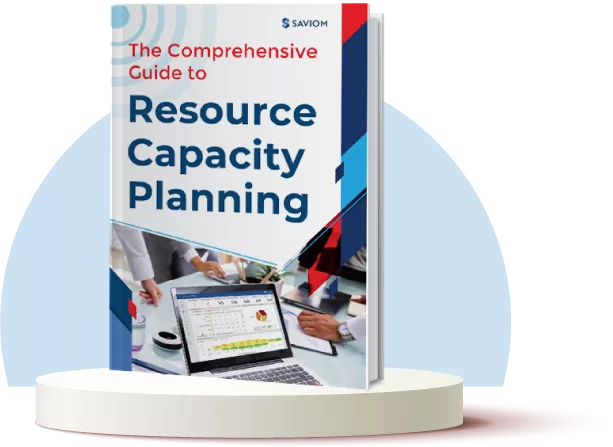Do your financial plans often fail to match actual project spending?
Is it difficult to control costs as your project evolves?
Do you fail to justify the planned vs. actual variances to stakeholders?
If yes, then you are probably missing one critical element – a clearly defined cost baseline. Over the course of the project lifecycle, costs may escalate due to various factors such as change in requirements, fluctuating raw material pricing, or unexpected resource constraints. Without a standard benchmark, managing these changes becomes difficult, leading to budget overruns and even project failure.
The cost baseline provides a financial point of reference, which allows managers to identify any deviations in advance and adjust the plan before the spending spirals out of control.
In this blog, we will learn about the nitty-gritty of what a cost baseline in project management really is, along with the steps for creating an effective one.
Let’s get started!
What is the Cost Baseline in Project Management?
A cost baseline is an approved budget that serves as a benchmark to monitor and control costs throughout the project lifecycle. It is time-bound and is typically developed after the scope and Work Breakdown Structure (WBS) are clearly defined. More importantly, the cost baseline offers a basis for comparing actual expenditure to the project’s planned costs.
Ideally, the cost estimates and actual project cost should match, or the actual costs should be lower than the cost baseline. If the actual cost is higher, it denotes overspending, which requires inspection and corrective actions to bring the project budget back on track.
Now that the cost baseline definition is clear, let’s understand what it includes.
Cost Baseline Components
Below are the various cost baseline components:
Work Package Costs
Work packages are the lowest level of deliverables in the work breakdown structure (WBS). The work package cost includes labor, materials, equipment, and other direct expenses. The sum of the costs of all work packages forms the foundation of the overall cost baseline.
Human Resources
A project requires various human resources with different skillsets, specialties, experience, and roles to complete the tasks efficiently. Their salaries, benefits, and compensation form a substantial amount of the total project budget. That’s why accounting for all the required resources is important to ensure accurate estimation.
Read More: Human Resource Planning: Importance, Processes, and Effective Strategies
Material Resources
Material cost comprises the price of equipment, machinery, raw materials, facilities, and software tools that are required for successful project completion. It is essential for managers to factor in these non-human resources as per project activity or phase to ensure accurate budgeting.
Time Estimates
After the cost estimation of human and material resources, the next step is determining the duration for which these resources will be allocated to the project. This time-phased budgeting helps managers assess the expenses accurately because the longer the resources are consumed, the higher the costs will be.
Read More: What is Time Management? 9 Effective Strategies to Master It
Contingency Reserve
Projects are prone to encountering unexpected expenses at some point; that’s why the cost baseline should include a contingency reserve to tackle the risks efficiently. Contingency reserves act as a financial cushion during project scope changes, price fluctuations, or delays in delivery, preventing cost overruns.
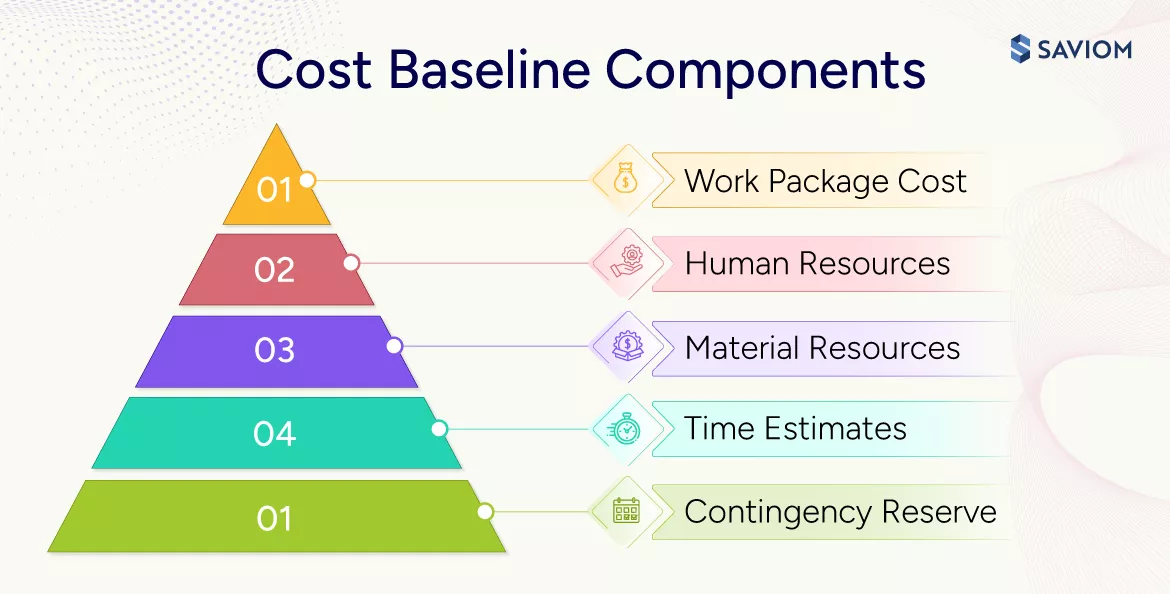
Now, let’s understand how the cost baseline and project budget are different from each other.
Cost Baseline vs. Project Budget
Here’s a rundown of the basic differences between the cost baseline and vs. project budget:
| Aspects | Cost Baseline | Project Budget |
|---|---|---|
| Definition | It is an approved, time-phased budget that helps measure project cost performance. | It combines the costs of all activities and resources required to deliver a project over a defined period. |
| Purpose | Helps in tracking and comparing planned vs. actual costs. | Ensures required funding is available to complete the project. |
| Includes | Work package costs + contingency reserves | Cost baseline + management reserves |
| Nature | It is time-phased, i.e., distributed over the project timeline. | It reflects the total cost and is not necessarily time-phased. |
| Usage | Used for cost performance measurement. | Used for cost planning, funding, and approvals. |
Now that the differences are clear, let’s move on to the advantages of having a cost baseline.
Read More: How to Develop an Effective Project Budget in 8 Simple Steps?
Benefits of Cost Baseline in Project Management
Creating an effective cost baseline is very beneficial for the project. Let’s understand how:
Helps Monitor & Control Project Cost
The cost baseline is a point of reference for all project-related expenses. It also allows project managers to effectively track actual vs. planned costs in real time. Moreover, with the help of the project cost baseline, managers can spot any deviations beforehand and take corrective actions like deploying resources from low-cost locations or cutting non-essential procurements to prevent cost overruns.
Improves Forecasts & Budget Accuracy
An accurate cost baseline allows managers to make more precise forecasts based on actual project progress and spending patterns. Additionally, it helps managers refine budget estimates and provides clarity on future funding needs. This approach tends to reduce any financial surprises during the course of the project.
Read More: What is Resource Forecasting? A Guide for Project Managers
Helps Measure Project Performance
A well-defined cost baseline plays a vital role in evaluating project performance through metrics such as Cost Performance Index (CPI) and Cost Variance (CV) as part of Earned Value Management (EVM). This enables managers to assess overall project performance by comparing the actual spending with the projected costs.
Boosts Stakeholder Confidence
A strong cost baseline equips managers to handle unexpected problems like resource shortages or scope changes without jeopardizing the budget. Moreover, it ensures accurate tracking of costs and precise financial reporting. This financial transparency and accountability boost stakeholders’ confidence and reassures them that the project is in capable hands.
Read More: Who are Project Stakeholders? 7 Effective Ways to Manage Them
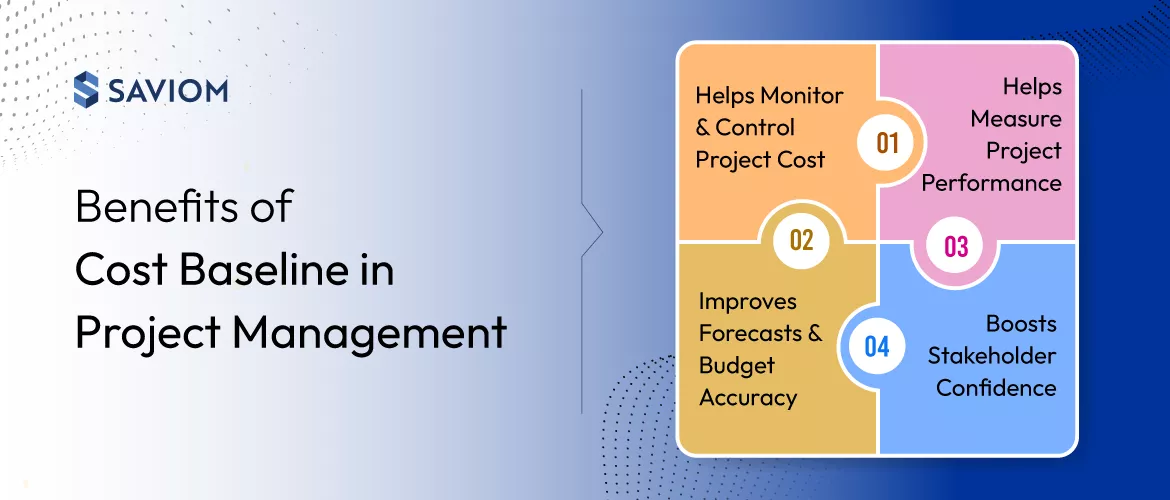
After benefits, it’s time to understand how a cost baseline is calculated.
How to Calculate Cost Baseline?
The project cost baseline is calculated by considering two attributes: project cost and contingency reserves. The formula for calculating the cost baseline in project management is –
| Cost Baseline = Project Cost + Contingency Reserve |
|---|
In this formula, the project cost includes the expense of all individual activities, which is generally calculated at the work-package level. This comprises direct and indirect costs such as manpower, raw materials, machinery, travel, training, facilities, software, etc. In addition, a contingency reserve is a fund that covers any unexpected issue that arises midway through the project.
To understand the concept better, let’s look at an example.
Cost Baseline Example
Let’s consider an example of setting a cost baseline for a building construction project.
- Project Goal: Construct a two-story, 5,000 sq. ft. office building
- Planned Duration: 8 months
- Objective: Complete construction within budget and timeline while meeting all quality and safety standards.
Step 1: Estimate Project Cost
| Cost Category | Estimated Cost |
|---|---|
| Labor | $150,000 |
| Material | $250,000 |
| Equipment & Rentals | $50,000 |
| Permits & Approvals | $10,000 |
| Subcontractor Fees | $40,000 |
| Total Project Cost | $500,000 |
Step 2: Add Contingency Reserve
Contingency reserve covers the project’s known and unknown risks, like weather delays, scope creep, or material price hikes. Let’s assume a 10% contingency.
| Contingency Reserve (10% of $500,000) = $50,000 |
|---|
Step 3: Final Project Cost Baseline
| Cost Baseline = $500,000 + $50,000 = $550,000 |
|---|
Read More: What is a Cost Breakdown Structure & How to Create One Effectively?
How the Cost Baseline is Used
This $550,000 cost baseline becomes the reference point for the project budget. As actual expenses are tracked throughout the project, managers will compare them against this baseline. If the actual spending hits $480,000 by month 6, then the project is within budget. However, if it’s $520,000, managers may need to reassess resource allocation or raw-material costs.
After looking at the example, it’s time to move on to the steps of creating the cost baseline in project management.
How to Create a Cost Baseline?
Here’s a rundown of the steps for creating an effective cost baseline for a project.
Define Project Scope & Create WBS
While creating baseline for the cost, managers can begin by defining the project scope first. It provides a detailed outline of the objectives, deliverables, tasks, deadlines, and constraints that should be accounted for to complete a project successfully. This helps managers precisely identify the actual cost required to fulfill the scope.
Next, managers can create a detailed work breakdown structure (WBS). It divides a project into smaller and manageable units called tasks, which are further broken down into various sub-tasks and work packages. This decomposition provides a complete overview of all the essential elements of the project.
Read More: How to Build a Work Breakdown Structure? A Step-by-Step Guide
Allocate Cost to Each Work Package
Now that the tasks, sub-tasks, and work packages are identified, managers can easily allocate the required cost to complete each and every work package effectively. This approach will ensure that all the work packages are funded accurately, and they can be completed on time without facing any budget constraints.
Let’s consider a marketing project in which a work package comprises social media ads. To complete it, the manager can allocate costs for market research, creative design, copywriting, ad creation, maintenance, and ad campaign. This detailed cost breakdown structure ensures that the team has the required budget to execute the task.
Add Contingency Reserves
Since cost estimations cannot always be 100% accurate, managers need to add a contingency reserve to the cost baseline in the next step. This contingency reserve can help cover any unexpected issues that arise during the course of the project, like unplanned resource attrition, sudden scope revisions, technical problems, vendor issues, etc.
Let’s take the example of a construction project. A contingency reserve can help cover issues like sudden price hikes in raw materials or delays due to machinery failure. By setting aside 15% of the estimated cost, the manager can ensure that such unforeseen issues don’t impact the timeline or escalate the budget at the last minute.
Read More: 10 Effective Strategies to Combat Unplanned Attrition in the IT Industry
Aggregate All Costs to Develop a Unified Budget
In the fourth step, managers can summarize the cost required for all the project elements and create a detailed project budget. The collective cost, including the contingency reserve, can provide a clear picture of how much money is required to complete the project. This, in turn, can help managers create a more precise cost baseline.
For example, in a product launch project, the manager aggregates costs for product design, packaging, marketing, logistics, and contingency funds. This helps create a unified budget that shows the project’s total financial requirement. It also allows stakeholders to track spending and make informed decisions throughout the project lifecycle.
Distribute the Costs Over the Project Timeline
After estimating the expense for each work package and creating the budget, managers can distribute the incurred costs across the project timeline based on when the work is planned. They can refer to the project schedule to determine the start and end dates of each work package and then allocate costs proportionally across those periods.
For example, the “foundation work” package might span two months in a construction project. In the first month, activities like excavation and formwork setup could account for 40% of the total foundation budget. In the second month, tasks like concrete pouring and curing may incur the remaining 60% of the cost might be incurred. This type of budget distribution aids in effective project cost management.
Read More: Project Cost Management: Types, Importance, and Steps to Calculate It
Get Approval for the Estimated Cost Baseline
The next involves reviewing the cost baseline with all the stakeholders involved. If they suggest any changes in the project cost baseline, managers can accommodate them quickly to make the estimates more precise. After that, managers can present the baseline again and get a final approval from the project stakeholders.
After approval, the cost baseline in project management acts as a point of reference for assessing the financial performance of the project. Managers can also document the changes suggested by stakeholders as a reference for upcoming projects to help ensure that the future cost estimations are on point.
Track & Manage Costs Throughout the Project Lifecycle
After creating the baseline, managers can keep track of all the expenses until the project is completed. They can utilize the earned value management technique, combining scope, budget, and timeline, to compare the planned vs. actual spending and spot variances. This helps in systematically comparing project performance to the baseline.
Moreover, to manage the cost, managers can deploy cost effective project resources from low-cost locations or secure raw materials from vendors at a lower price through negotiation. These will help ensure alignment with the budget throughout the project lifecycle, without affecting the quality of the deliverables.
Read More: What is a Project Lifecycle? Phases, Importance, & Best Practices
Now, let’s see how advanced resource management software can prove beneficial.
How Can 5th Gen Project Resource Management Help?
A 5th gen resource management software can help in managing project costs by providing better visibility, accurate planning, and efficient utilization of resources throughout the project lifecycle.
- The all-in-one resource planner enables managers to filter resources by skill, experience, role, and cost rate. This helps managers effectively allocate resources from low-cost locations to prevent cost overruns.
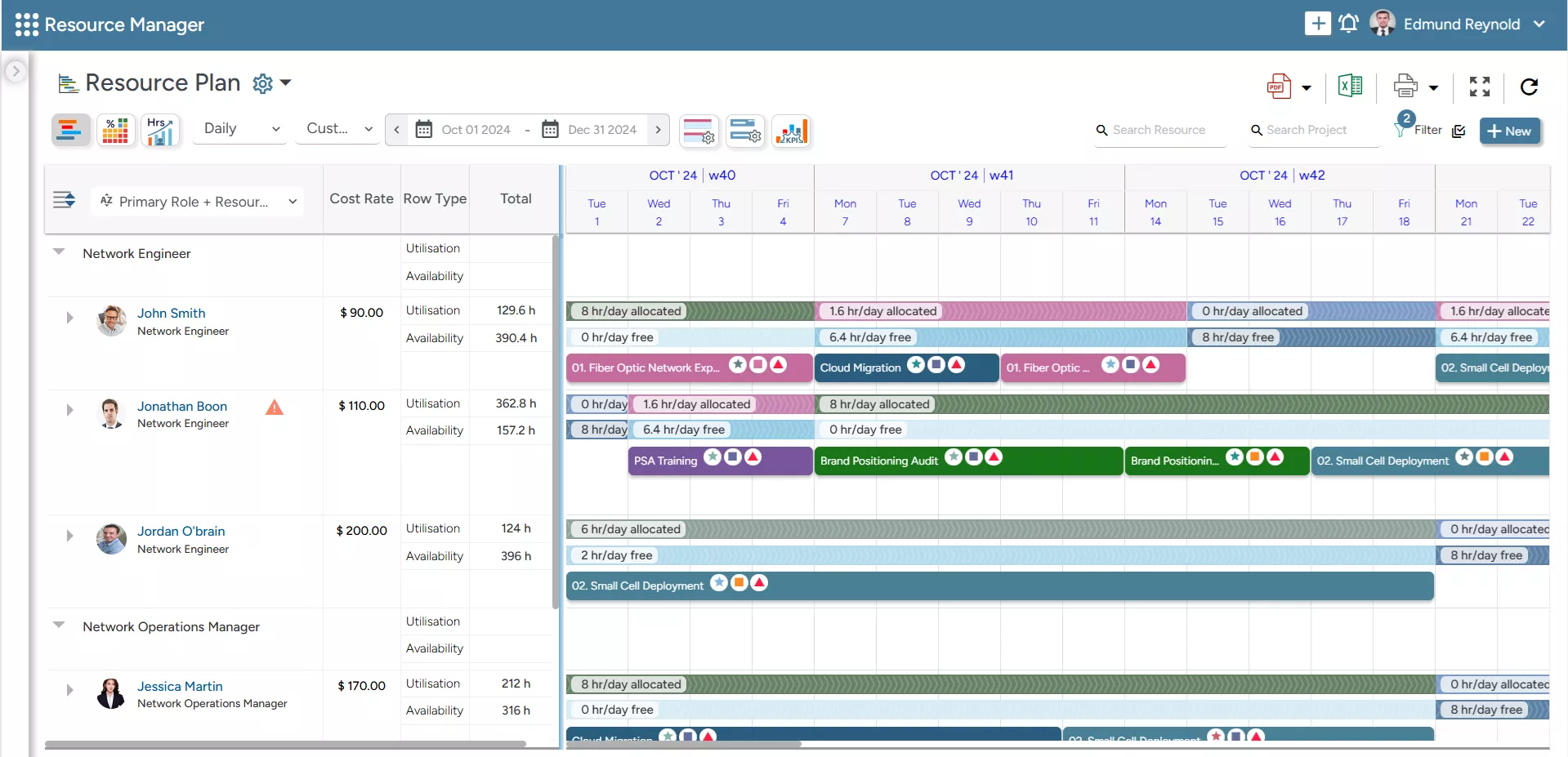
SAVIOM’s All-in-One Resource Planner provides 360-degree visibility of all resources, allowing managers to make data-driven decisions.
- Its embedded capacity planner lets business leaders anticipate short and long-term resource requirements. Thus, it prevents the risk of last-minute, costly hiring that can derail the project budget.
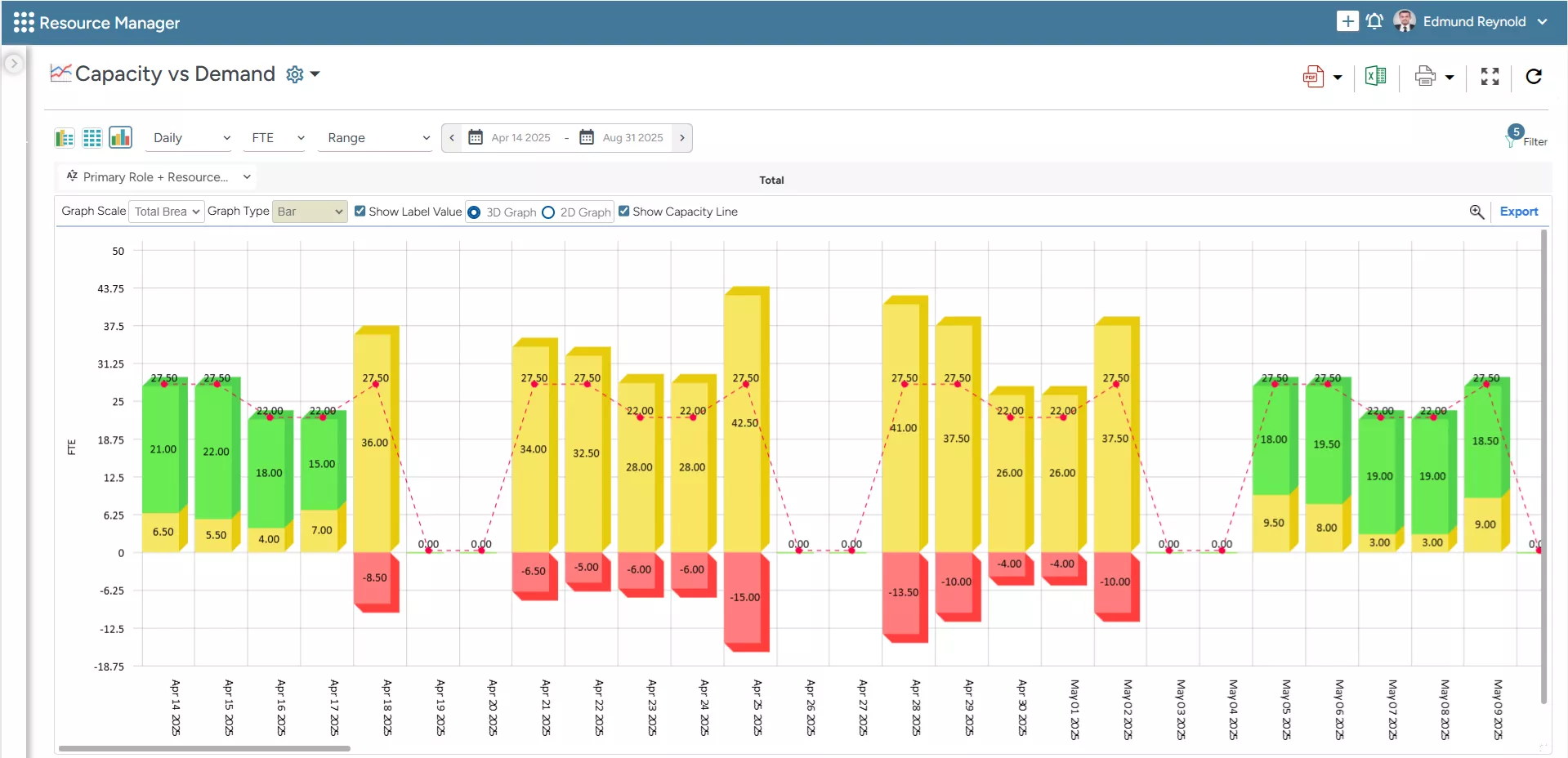
SAVIOM’s Capacity vs. Demand dashboard displays resource capacity and demand patterns graphically and highlights any resource shortages.
- The intelligent match-making feature ensures that managers assign the right resources to the right task at the right cost. This helps assess the precise cost for each of the resources.
- The tool’s early warning system alerts managers during resource overloading, double bookings, etc. This prevents instances of employee burnout and unplanned attrition.
- With the tool’s smart KPI forecaster, managers get real-time insights into some key resource metrics such as resource availability, utilization, and capacity. This helps avoid inefficient allocation and underutilization, which can distort the cost baseline.
2. The resource forecasting feature of the tool enables managers to anticipate future resource demands so that they can assess the cost required to cover them.
3. The tool’s real-time BI reports provide insights into forecasted cost versus actual expenditures, helping you track the variances and take corrective actions beforehand.
4. With the what-if analysis feature of the tool, managers can create and compare various scenarios under different business conditions. Thus, it helps them simulate potential risks such as talent shortages or unavailability and develop the most profitable resource plan.
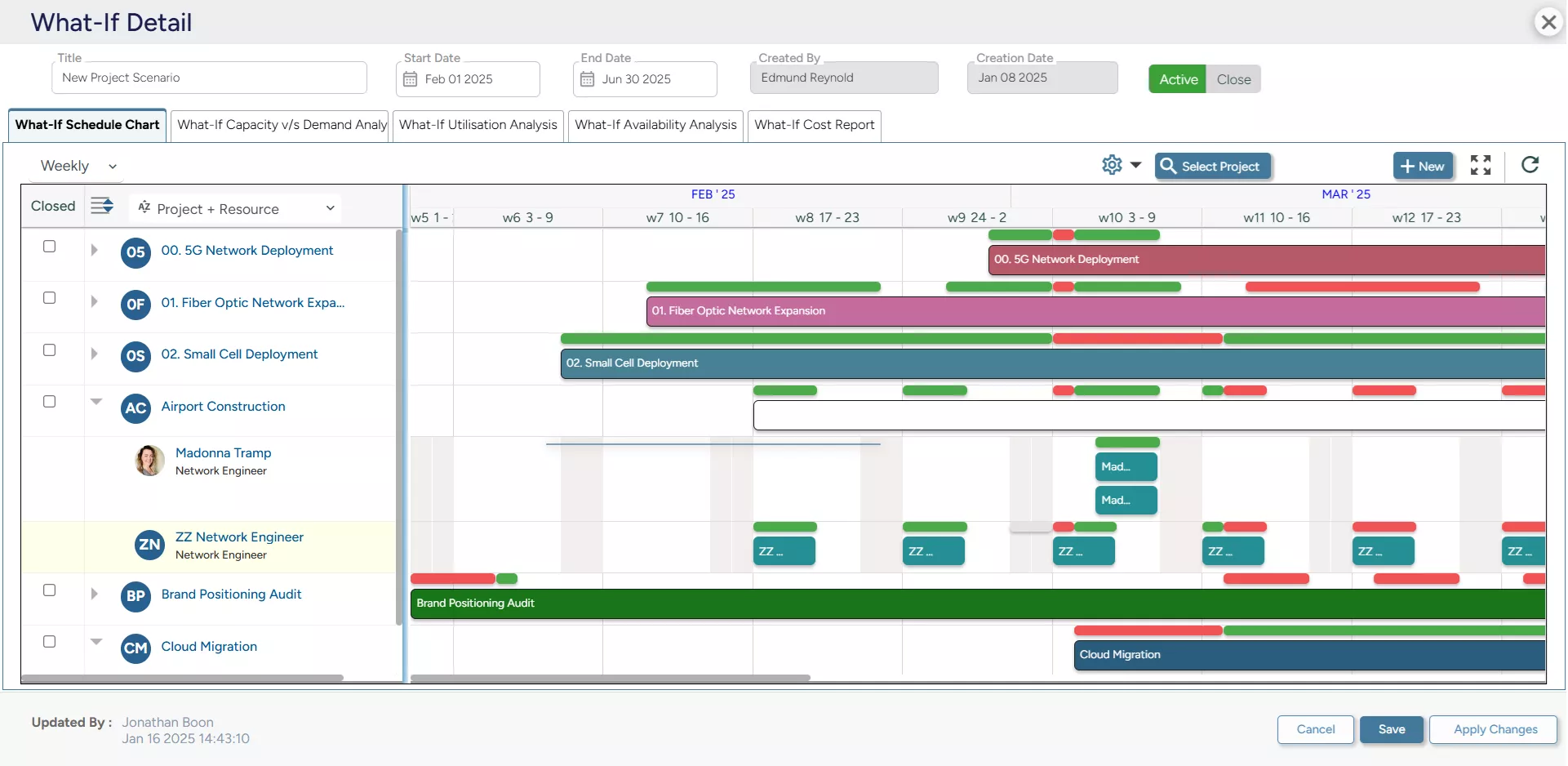
SAVIOM’s What-if Analysis feature enables project managers to perform scenario modeling in a sandbox environment to assess the impact of various decisions and finalize the best-fit plan.
Key Takeaways: Tips to Manage the Cost Baseline
All in all, establishing a well-defined cost baseline is essential for maintaining financial control and ensuring the success of any project. It provides a clear benchmark for tracking actual costs and enables proactive decision-making, accurate forecasting, and transparent communication with stakeholders. Here are some quick tips that you can follow to create and maintain the expenses in your projects:
- Keep measuring and comparing the cost to the baseline to ensure it aligns with the budget throughout the project lifecycle.
- Regularly monitor the cost performance indicators like cost performance index (CPI), actual cost (AC), and earned value (EV) to ensure there are no deviations.
- Use reports like forecast vs. actual cost to identify any variances early.
- Establish a formal change control process for documenting, reviewing, and approving project modifications to maintain financial stability.
- Communicate the project cost status with stakeholders to ensure transparency and proper alignment.
- Leverage a robust project budgeting tool to streamline cost management and improve the accuracy of future budgets.
The Glossary
Read More: Glossary of Resource Workforce Planning, Scheduling and Management




